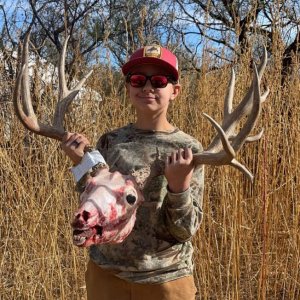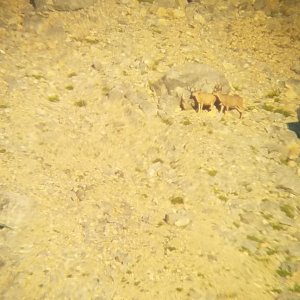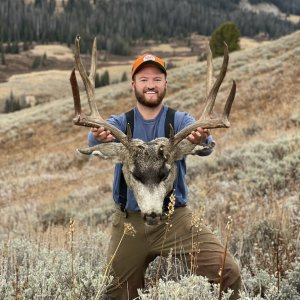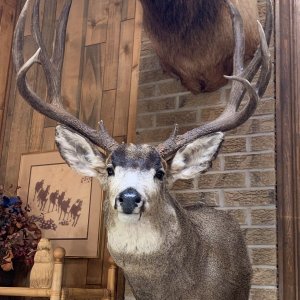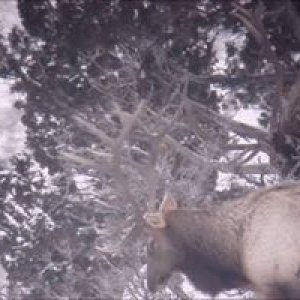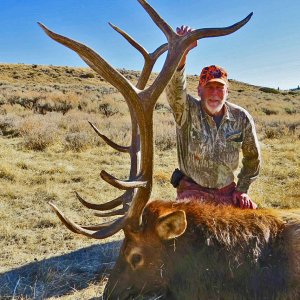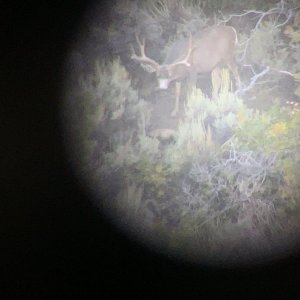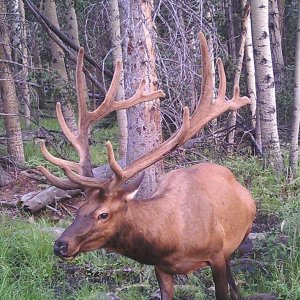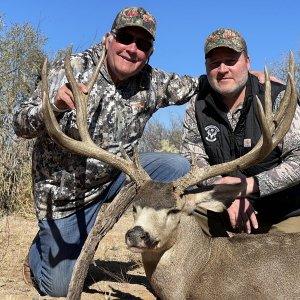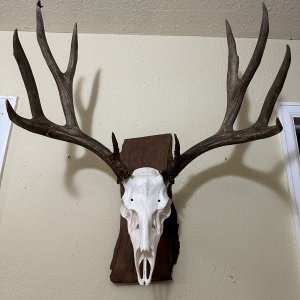Minutes after being captured in the mountains surrounding West Riverside, a bighorn sheep is unloaded from a helicopter to be studied by veterinarians and biologists from Montana and Utah. The sheep are being rounded up and relocated to the northeast corner of Utah by the Utah Division of Wildlife Resources and Montana Fish, Wildlife and Parks.
Photo by LINDA THOMPSON/Missoulian
WEST RIVERSIDE - Its eyes covered and legs securely hobbled, the young bighorn ewe lies almost perfectly still atop a makeshift platform built of hay bales.
A host of different hands are quickly and quietly going about their jobs of taking blood, swabbing saliva and performing a variety of other examinations. A collar equipped with a small silver radio is attached around its neck and a red numbered tag pinned to its ear.
After uttering hardly a word, a pair of Carhartt-clad men pick up the ewe and pack it to a nearby horse trailer. A minute later, the hobbles are off and the hood removed, and the bighorn settles into its new home for the next couple of days.
It has plenty of company.
By the end of Wednesday, the crew gathered at the nearly empty log yard at the Stimson Lumber mill at Bonner worked over a total of 27 bighorn sheep plucked off the nearby hillside by a helicopter crew from New Zealand.
That total included seven rams that were either yearlings or 2-year-olds and 20 ewes ranging from yearlings to somewhere around 10.
Over the next couple of days, biologists from both Montana and Utah are hoping to capture up to 40 bighorns from both the Bonner and lower Rock Creek areas. Within a few days, the bighorns will be released in their new home in the Flaming Gorge area of northeastern Utah.
The Utah Division of Wildlife Resources is footing the bill for the operation.
Bob Henderson, a local biologist with Montana Fish, Wildlife and Parks, is happy to see the bighorns go. Henderson estimated the bighorn herd at Bonner had grown to nearly 150 and was starting to take a toll on shrubbery and other tasty morsels in the West Riverside area.
?We get quite a few calls from people around West Riverside,? Henderson said. ?Most people kind of like having them around, but there's a few who weren't quite so happy. ... Some people have some legitimate complaints about what the sheep were doing to their shrubbery.?
The ideal herd size for the Bonner area is probably closer to 100, he said.
Concerns over nibbled shrubbery isn't the only or most important reason biologists around the state want to keep bighorn sheep numbers in check.
Montanans have seen some of the finest herds of bighorn sheep go through dramatic die-offs over the past decade. Some speculate the die-offs might be brought on when herd numbers swell and habitat suffers.
After several mild winters, Montana's bighorn populations have rebounded to the point that some herds are getting on the verge of being too large. In years past, the state might have moved the overflow to places where numbers were down or maybe even a new spot or two.
But that's not going to work this time around. There aren't any new places, and all the old places are pretty much filled up.
So Montana is looking to other states to take the overflow.
There have been plenty of states willing to step up and take a few dozen sheep to help replenish their own herds.
Bighorn sheep from the Missouri Breaks and the Rocky Mountain Front are headed to Nebraska and North Dakota. Sheep from Thompson Falls are going to Wyoming. And Utah will be getting bighorns from Bonner, Rock Creek, Sula and the Rocky Mountain Creek.
?Right now, the most secure bighorn sheep populations in the lower 48 states are here in Montana,? said FWP biologist Ray Vinkey.
Credit that both to decades of hard work by a corps of dedicated volunteers and professional biologists.
In the 1960s, the only large remnant herd of bighorn sheep in the state was in the Sun River area. About then, a few biologists and some others began capturing a few from there and relocating them into areas considered historic sheep habitat.
Over the years, the number of herds in Montana grew.
The Bonner herd was started in 1987 with about 30 sheep from the Sun River herd. In 1996, 30 bighorns from that herd were transplanted to the Elkhorn Mountains, which has since become its own success story.
?Montana has been very successful in its translocation efforts with bighorn sheep,? Vinkey said. ?It's a real legacy to the sportsmen of this state.?
Montana's not alone in its efforts to restore bighorn sheep populations.
Significant changes in habitat, competition from livestock and over-hunting had nearly wiped out bighorn sheep in Utah by 1970, said Charlie Greenwood, a Utah wildlife biologist.
The state has been working to bring back the breed since 1983. So far, it's transplanted five different populations. The 40 bighorns being gathered near Missoula this week will make six.
Greenwood said the Montana bighorns will find a different, but inviting landscape, when they arrive at their new home. A 20,000 acre fire in 2002 opened up the countryside and made some excellent sheep habitat.
?It was reseeded after the fire and there's just some incredible feed there for them now,? he said.
Utah now boasts three different subspecies of bighorns, including Montana's Rocky Mountain version, as well as Californians and desert sheep.
Neil Anderson, FWP's wildlife lab supervisor, worked with others to ensure the sheep leaving Montana were in prime condition. His crews also gathered samples of blood and saliva that could help uncover valuable information about bighorn sheep.
?Every sheep we handle gets the same treatment,? Anderson said. ?All the information we gather provides us with some good baseline information that we can use if something new ever pops up.?
On Wednesday, Anderson has teamed with David Wick, the president of BVS Inc. of Stevensville to try some cutting-edge technology to detect different viruses carried by bighorn sheep.
Pneumonia and other respiratory diseases are often associated with the large die-offs experienced periodically by bighorns. The researchers hope that a test developed by Wick's company will help unlock some of the mysteries about how the sheep react to different viruses.
Wick's company has developed a new method for detecting and identifying viruses by separating them out according to size.
?This is cutting-edge technology,? Wick said. ?We've been working with the military. This is the first time we've tried this application with wildlife.?
Anderson is hopeful about the information that might be gleaned from the tests.
?Right now, there's still a lot we don't know about what triggers these disease outbreaks,? Anderson said.

